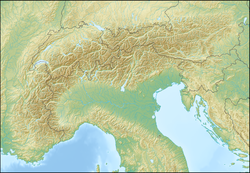
Back جبل هوتشكالتير ARZ Hochkalter CEB Hochkalter German Hochkalter French Hochkalter Italian Hochkalter LLD Hochkalter Polish 霍赫卡爾特山 Chinese
| Hochkalter | |
|---|---|
 View of the Hochkalter and Blaueis, from the north | |
| Highest point | |
| Elevation | 2,606.9 m (8,553 ft) |
| Prominence | 663 m (2,175 ft)[1] |
| Parent peak | Watzmann |
| Isolation | 4.5 km (2.8 mi) |
| Coordinates | 47°34′09″N 12°51′56″E / 47.56917°N 12.86556°E |
| Geography | |
| Location | Germany (Bavaria) |
| Parent range | Berchtesgaden Alps |
| Climbing | |
| First ascent | Prince-Bishop Schwarzenberg with Gemminger, Tatz and Wein, 1830 |
| Easiest route | From the Ofen valley, grade I |
| Normal route | over the "Schönen Fleck" from the Blaueishütte, grade II |
At 2,606.9 metres (8,553 ft),[2] the Hochkalter in the Berchtesgaden Alps is the highest peak in the massif of the same name and therefore one of the highest mountains in Germany. The Hochkalter Massif (German: Hochkalterstock or Hochkaltermassiv) is also called the Hochkalter mountains (German: Hochkaltergebirge).
The Hochkalter massif lies west of the Watzmann massif and, like it, is located within the Berchtesgaden National Park. The Hochkalter mountains are divided into sub-groups known as the Hochkalter Group (Hochkalter-Gruppe), Hocheis Group (Hocheis-Gruppe) and Southern Wimbach Chain (Südliche Wimbachkette). The most important base for climbing this alpenstock is the German Alpine Club's Blaueis Hut (Blaueishütte, literally "Blue Ice Hut") which lies at a height of 1,653 metres (5,423 ft) in the Blaueis Cirque (Blaueiskar) below the Blaueis, the most northern glacier in the Alps. Other mountain huts are the Bergheim Hirschbichl for the Hocheis Group, the Wimbachgries Hut (Wimbachgrieshütte) for climbs up the eastern flanks of the massif and the Ingolstädter Haus for the Southern Wimbach Chain.
- ^ The key col is NW of the Sigeretkopf and is 1944 m according to SRTM. The Wimbachscharte SE of this summit is higher. See the BEV map and the Peakbagger entry
- ^ According to information from the Bavarian Survey Office (Bayerischen Landesvermessungsamt) in 2008, the exact height is 2,606.9 m. The figure of 2,606 m given on many maps is due to the decimal place being deleted without rounding the figure up.
